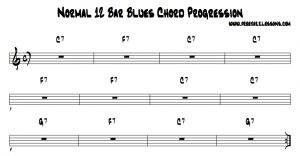A bit blurry...but that doesn't matter, because you have it memorized, and it is crystal clear in your mind!
We see that each measure has a corresponding chord symbol, C7, F7 or G7.
For Bb instruments the chords are D7, G7, A7 -- one whole step up from the "C Concert" chord changes.
As discussed, C7 is shorthand for C Dominant 7 meaning in this measure, play a C Dominant 7 chord and C dominant material in this space.
Who remembers putting material through progressions?
Our progression is a 12 bar blues. But what is the material?
Last week, we discussed the use of chord tones as material, i.e., soloists play the notes C, E, G, Bb while a piano (or guitar, or organ, etc...) plays the notes C, E, G, Bb all at once, though not necessarily in that order. Sometimes they play inversions of the chord:
Root position: C, E, G, Bb
First Inversion: E, G, Bb, C
Second Inversion: G, Bb, C, E
Third Inversion: Bb, C, E, G
Soloists can also use inversions as material. For example, the first chord of the C Blues is a C7. A soloist can play any of the above four inversions sequentially.
Instead of playing C - E - G - Bb in measure one of the C blues, soloists (and bassists) can play E, G, Bb, C or G, Bb, C, E, etc...
Soloists can also play Dominant scales over a rhythm section playing Dominant chords.
It's measure 1 in the C blues. The chord is C7
The piano plays a C7 chord
The bass plays a C7 chord
The soloist plays a C Dominant scale in eighth notes: C D E F G A Bb C (one measure of 8th notes in 4/4 time)
and in so doing, arrives at the next chord, an F7.
The soloist plays the F Dominant scale in 8th notes: F G A Bb C D Eb F
Then, measure 3 and 4, back to the C7 chord.
The soloist plays the C7 Dominant sale in 8th notes, up and down: C D E F G A Bb C | C Bb A G F E D C.
This approach to doing things is carried out over the next 8 bars over the chords F7, C7 and G7.
This approach to doing things is called "outlining the chord". It is not called music, though it may sound musical...at first.
Soon it will sound tedious.
What to do? More importantly (in the Fish / Fishing pole way) how does one find out what to do?
I'll tell you. One consults books. These books are often written using notes. IF they aren't (like this blog) they probably aren't worth reading.
One of the great pedagogues in Jazz is also one of the great saxophonists -- Jerry Bergonzi. He wrote a few books. We are going to, for educational purposes, take a look at some strategies for decorating a 7th chord played by a rhythm section from his book Inside Improvisation Series, Vol. 3 <<Jazz Line>> put out by the Advance Music company.
ok...take two.
Bar one of the C blues. A C7 Chord. Piano and bass (the rhythm section) are playing C7 material, either by "chording" (piano) or by "walking" bass.
Where as before the soloist played a C Dominant scale [C D E F G A Bb C] the soloist now plays a Dominant Bob scale: C D E F G A Bb B | C
TO FORM A BOP SCALE ADD THE EXTRA NOTE BETWEEN THE ROOT AND THE DOMINANT SEVENTH.
hold up! that's 9 notes...and you can only fit 8 in a measure!
TRUE! AND look what note you land on in the next measure. You land on a C ! Which also happens to be a chord tone in an F7 scale! It's the 5th!
Do you know what else? You can start playing a Dominant Scale on the 5th! And so:
Measure 1: C7 --> C E G Bb ---> C D E F G A Bb B | C
Measure 2: F7 --> F A C Eb ---> C D Eb E F G A Bb | C
Measure 3: C7 --> C E G Bb ---> C D E F G A Bb B | C
Measure 4: C7 --> C E G Bb ---> C B Bb A G F E D | C (backwards that time)
the magic of the Bop scale is it "set's you up" for the next measure when moving by 4ths, as one often does in a 12 bar blues.
To make sure: A Dominant Bop scale is a Dominant Scale (mixolydian) with the ADDITION of a natural 7. And if you look really carefully, THE LAST FOUR NOTES IN THE BOP SCALE ARE ALL A HALF STEP APART.
C D E F G A Bb B C
D E F# G A B C C# D
and so forth
Dominant Bop Scales, as well as Dominant Scales, as well as all material can (and should) be played going from high to low. I have not done a thorough statistical inquiry, but from what I've heard a huge part of the Jazz Language, a key factor in sounding convincing when speaking the language of Jazz through your instrument is "phrasing backwards"...starting up high and going down low.
In the case of the Dominant bop scale, that's 4 notes separated by a half step. 4 chromatic notes. High to low. So in C you play C, B, Bb A.
EASY AND SIMPLE!
C Concert musicians--have C, F and G dominant scales totally under control
Bb instruments, the same, but for D, G and A.
Lastly, why not spend the week listening to Sunny Stitt?


